F-Type by Jaguar
The F-Type, the follow-up to British brand Jaguar's iconic E-Type and the first new sports car in this series in over 50 years, has finally gone on sale (+ slideshow).
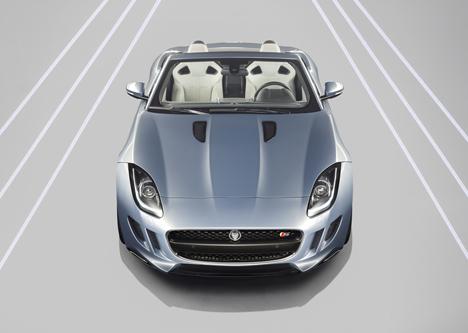
Jaguar director of design Ian Callum told Dezeen that the new model revisited the "Coke-bottle shape" of previous sports cars in the series, such as the 1950s D-Type and the famous 1960s E-Type.
"We like to imply a sense of that Coke-bottle shape in the line," Callum said. "It was in the D-Type and E-Type and you can see that curvaceous line in the F-Type as well. Primarily [the design] was about following the rules of proportion, form and line."
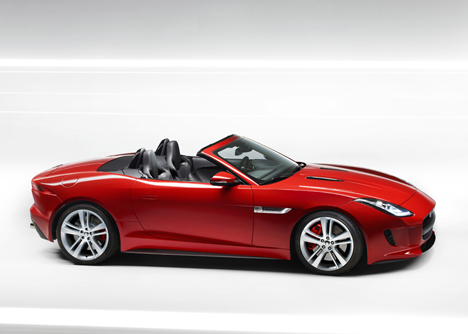
The car body and suspension are built from lightweight aluminium, and the chasis is proportioned to create the illusion of an elongated front.
"In order to exaggerate the length of the bonnet, and to give the F-Type fascinating and exciting proportions, we thought the rear should be shorter," said Callum. "That imbalance is what gives the car an exciting stance."
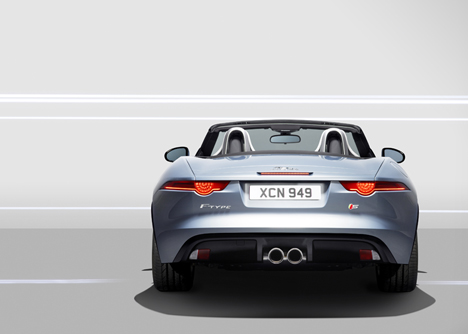
Details such as the grille and rear lights are also based on features from previous sports cars in Jaguar's range: "[The details] exaggerate some of the lines and some of the features of the car in a way that enhances the overall proportions of the vehicle," Callum said.
"Their main purpose is to enhance the fundamental purity of line and beauty of form," he adds. "For instance, the headlamps follow the shape of the vehicle’s lines, the grille is assertive and identifies it as part of the [Jaguar] family and the wheels have to be exciting."
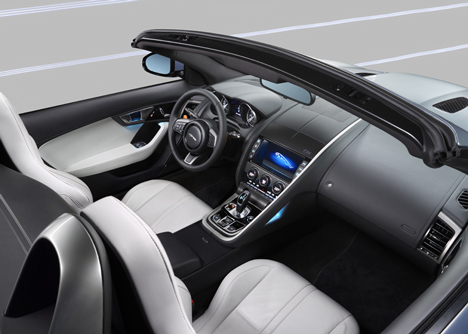
Discrete technologies such as a deployable rear spoiler and door handles remove interruptions from the lines of the chasis.
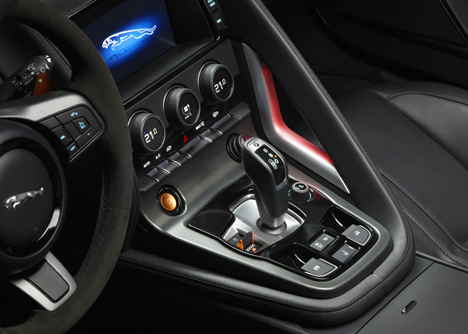
The inside is modelled on a jet fighter cockpit, with a gearstick shaped like a joystick and the centre console acting as a control panel of buttons and switches.
"The brief was to make the interior unashamedly driver focussed," said F-Type chief designer Alister Whelan. "It is supposed to be just that little bit selfish."
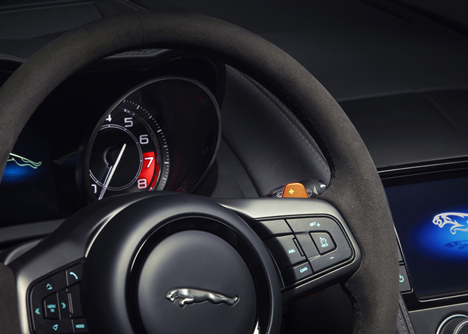
Paddles mounted on the steering wheel can be used to manually change gear, a common feature in Formula One vehicles, and important buttons are picked out in bronze.
The car was first unveiled at the Paris Motor Show last September and has since gone on sale worldwide.
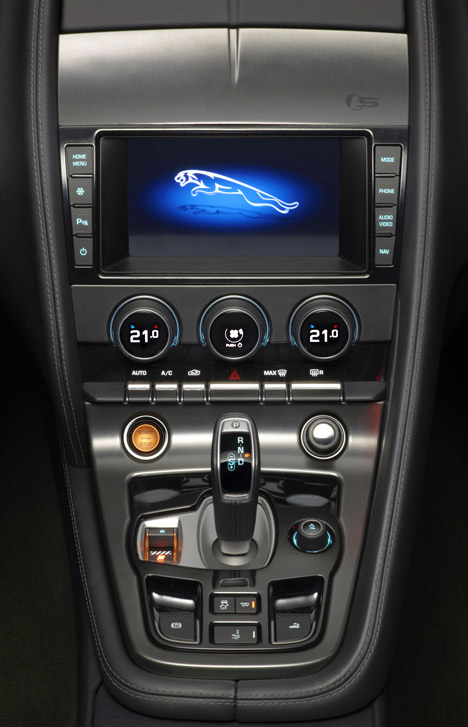
We also spoke to Callum at Clerkenwell Design Week 2011, where he told us about Jaguar's C-X75 electric concept car.
At the same event last year, we filmed Jaguar clay modeller Charles Douglas explain the process of turning a designer's sketch into a 3D model as he sculpted the form of what was to be revealed as the F-Type.
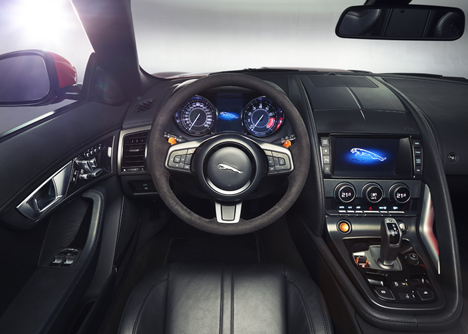
In other automotive news, the first solar-powered family vehicle is due to race across Australia and a flying car capable of vertical takeoff and landing has been unveiled.
See more design by Jaguar »
See more car design »
Read on for Jaguar's press release:
The new Jaguar F-TYPE represents a return to the company’s heartland: a two-seater, convertible sports car focused on performance, agility and driver involvement. The F-TYPE is a continuation of a sporting bloodline that stretches back more than 75 years and encompasses some of the most beautiful, thrilling and desirable cars ever built.
The engineering ethos underpinning the F-TYPE is centred on Jaguar’s industry-leading expertise in the use of aluminium. Featuring the most advanced iteration of Jaguar’s acclaimed rigid and lightweight aluminium architecture to date, the F-TYPE has ideally balanced weight distribution that allows its involving rear-wheel drive dynamics to be explored to the full. Utilising extensive Computer Aided Engineering programmes, the attention to detail involved in the F-TYPE’s creation even extended to the development of a new, lighter, aluminium front subframe.
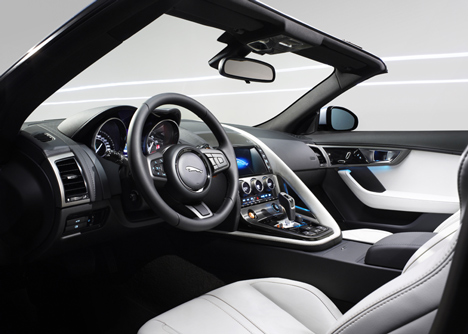
In order to maximise the benefits of its advanced structure, the F-TYPE features all-aluminium double wishbone front and rear suspension and a quick-ratio steering rack for ultimate responsiveness. The aluminium architecture has been optimised to provide the stiffest possible underpinnings for the suspension with rigidity gains of more than 30 per cent in key areas compared to any other Jaguar application.
Three variants will be available at launch – F-TYPE, F-TYPE S and F-TYPE V8 S. Each is distinguished by the power output of its supercharged petrol engine with all engines featuring stop/start technology to maximise efficiency.
A new 3.0-litre V6, developed from Jaguar’s highly acclaimed 5.0-litre V8, is available in either 340PS or 380PS variants, powering the F-TYPE and F-TYPE S respectively. Both applications exhibit the same free-revving, willing nature that encourages the enthusiastic driver to explore the full extent of the engines’ abilities.

The V6 models are joined by a newly developed member of Jaguar’s V8 engine family. Producing 495PS and 625Nm of torque in the F-TYPE V8 S model, it has an astonishing torque-to-weight ratio of 375Nm/tonne, accelerates to 60mph in 4.2 seconds (0-100km/h in 4.3 seconds) and on to an electronically limited top speed of 186mph (300km/h) while emitting 259g/km of CO2.
The 380PS V6 F-TYPE S covers the 0-60mph sprint in 4.8 seconds (0-100km/h in 4.9 seconds) and has an electronically limited top speed of 171mph (275km/h), with CO2 emissions of 213g/km.
The 340PS V6 F-TYPE accelerates to 60mph in 5.1 seconds (0-100km/h in 5.3 seconds) and on to an electronically limited top speed of 161mph (260km/h), while emitting just 209g/km of CO2.
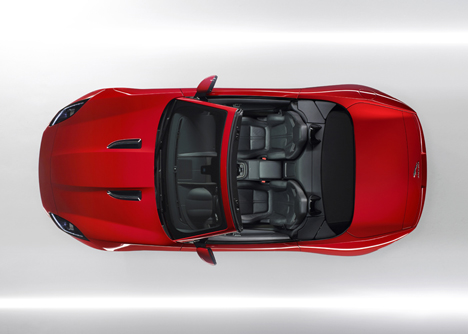
An active exhaust system, which is standard on the S and V8 S models, adds another dimension of driver-engagement. Valves in the exhaust system open under load from 3000rpm which allows the exhaust note to build to a thrilling crescendo at the redline.
The F-TYPE has a set of eight closely-spaced, sporting ratios in its Quickshift transmission, giving greater driver control. The V6-powered S model also includes a Dynamic Launch feature, which optimises acceleration from rest.
The company’s eye to the future is encapsulated in the assertive design language that deliberately challenges preconceptions. Jaguars have always defined sinuous, muscular simplicity and the F-TYPE is no exception, its shape being defined by two ‘heartlines’ forming the front and rear wings.
Taking inspiration from the C-X16 concept unveiled in 2011, the front of the F-TYPE features a new interpretation of the bold angular Jaguar grille from which flows the muscular clamshell bonnet with its signature ‘power bulge’. The all important heartline begins its journey in the blade dissecting the shark-like gills on either side of the grille before leading the eye to the top of the front wing, emphasised by the bi-xenon headlamp and integral LED daytime running lights, into the door and towards the rear of the car where it gracefully disappears.
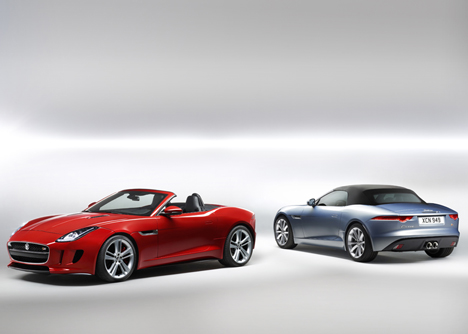
Its journey is taken up at this point by the second heartline which swells out to form the muscular rear haunch before sweeping dramatically around the sensual low tail, made possible by the inclusion of an active rear spoiler which deploys at speed to reduce lift by up to 120kg. Full LED rear lamps create a new Jaguar sports car signature by reinterpreting classic cues from the past and, by wrapping around to the trailing edge of the rear wheelarch, emphasise the powerful stance of the car and its rear-wheel drive sporting potential.
The focus on driver involvement and sporting performance in the F-TYPE is emphasised by the ‘one plus one’ layout of the asymmetric cabin. This is evidenced by the grab handle which sweeps down the centre console on the passenger side, delineating it from the driver’s position. Further differentiation is provided by the use of different trim materials either side of the cabin, with a more technical finish on the driver’s side.
Taking inspiration from cockpits of fighter airplanes, the controls are ergonomically grouped by function. Further aeronautical inspiration can be found in the joystick-shaped SportShift selector controlling the eight-speed transmission. The air vents on top of the dashboard will only deploy when instructed to by either the driver or complex control algorithms, staying tucked discreetly out of sight in other circumstances.